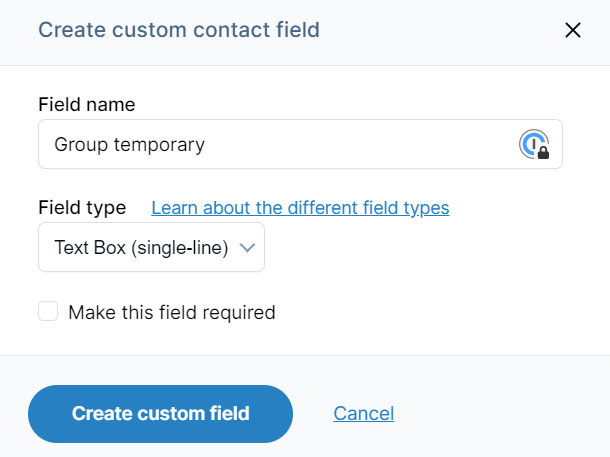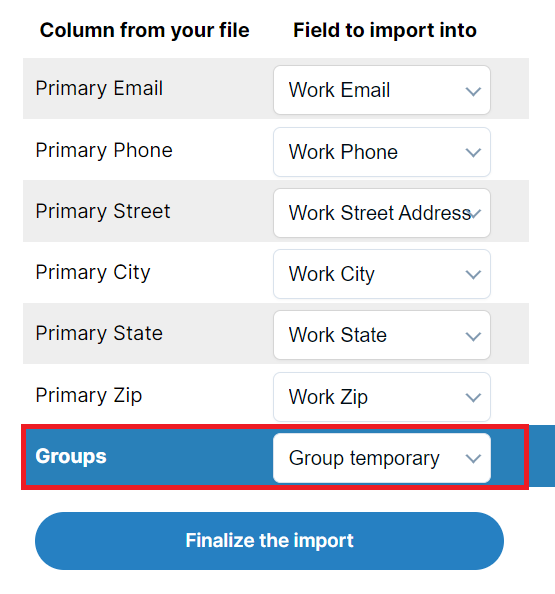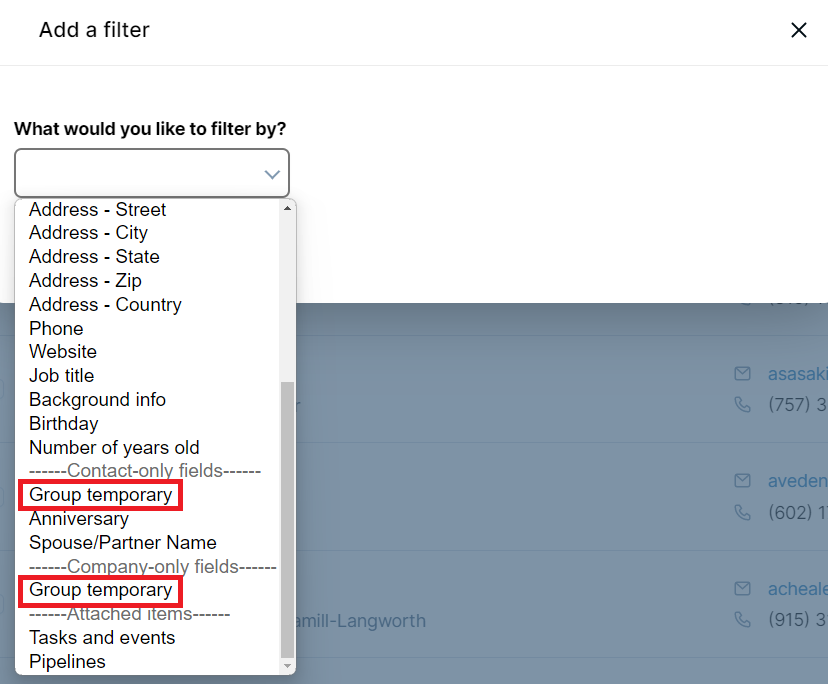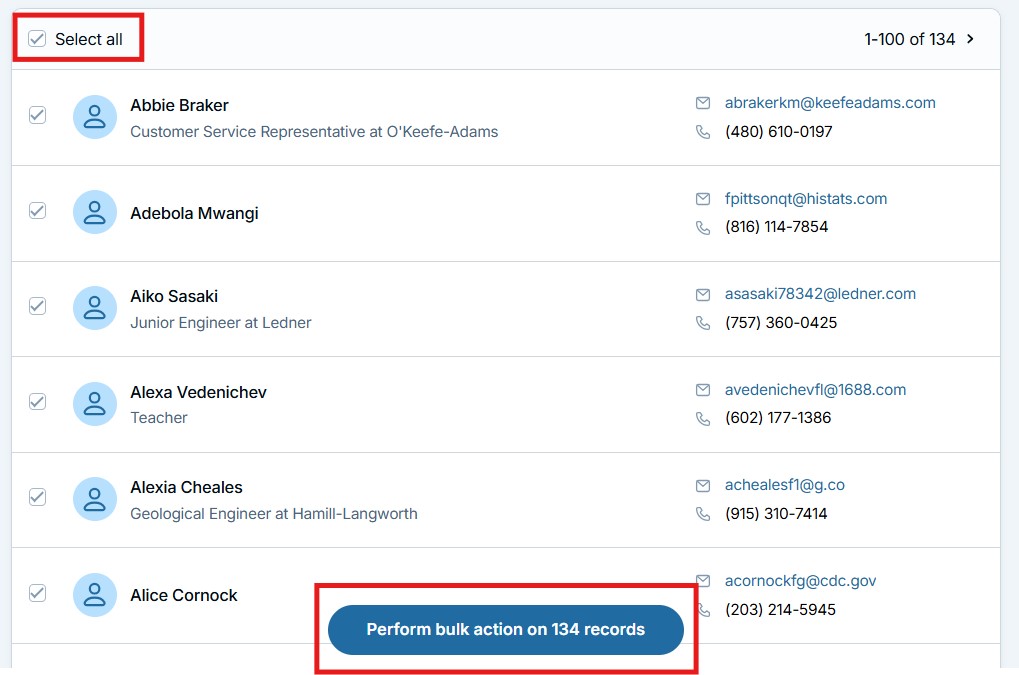Here's how to add one import to different groups:
Step 1: Format group data in your spreadsheet into a single group column.
- Make sure that your file has a single column that lists all of the group data.
- If a contact should be in more than one group, each group name should be listed in the same cell. For example a contact in both a Client and Newsletter group would appear "Client, Newsletter."
Step 2: Add a custom field for the group column data.
- Mouse over "Settings" and select "Custom fields" in the menu.
- Select either Contacts or Companies, depending on which record type(s) you'd like in your groups.
- Select "Create new custom field" at the top to create a new custom field. Name the field something that makes sense to you, and keep in mind that you can delete this field later.
- Please note: if you want both contacts and companies added to the same group you'll need to create two custom fields with the same name, one on the contact and one on the company.
Step 3: Import your spreadsheet, being sure to match your group data column to your custom field(s).
- Mouse over "Add" and select "Import contacts" in the menu.
- Select the "Import a spreadsheet" option to upload your file, and then follow the prompts. Learn more about running an import here.
- During the final step of the import, be sure to map your group column to the custom field(s) you added earlier.
- Please note: if you want both contacts and companies to be grouped you'll also need to choose "Both" in the "Record to import into" section.
Step 4: Filter by your group custom field(s), and bulk add the contacts to the appropriate group(s) in the CRM.
- Go to your Contact list. Select "Add a filter" in the “Sort and filter” section on the left.
- Select your custom field, and then type in one group name - spell it exactly the same way it appears in your file. Apply the filter.
- Tick the "Select all" box in the upper left. If you have over 100 contacts, you'll also need to click the option to select them all.
- Select “Perform bulk action on records” near the bottom of the page. In the dialog that opens, select “Attach an item.”
- Choose "Group” in the dialog, and then select the appropriate group or create a new one. Select the button “Attach to records” to confirm.
- That's it! If necessary, clear your filters, and repeat this process for each additional group.
- Please note: if you want both contacts and companies added to the group, you'll need to run each filter twice. Filter once by the contact custom field to add contacts to the group, and filter again by the company custom field to add companies to the group.
Only need to add the import to one group? Learn how to add the entire import to one group here.
Step 1: Format group data in your spreadsheet.
In order to import the group data properly, you'll need to format the file so you have a single “Group” column. That single column should have the group membership for the corresponding contact. If one contact should be in multiple groups, each group name should be listed in the same cell.
Learn more about formatting your file for import here.

Step 2: Add a custom field to import group data.
Once your file is ready for import, create a custom field to bring in your group data. This is a temporary field that we’ll use to filter contacts and add them to groups, but after that’s done it can be deleted. One important note here is that if you wish to have both contacts and companies added to groups, you’ll need to create two custom fields, one for contacts and one for companies.
Please note: only admins can add custom fields. If you don’t see an option to add custom fields you’ll need to contact an admin on your account.
Mouse over “Settings” in the navigation bar, and then select “Custom fields.” On the next page, select “Contacts” if you want the contacts to be grouped, or “Companies” if you want companies to be grouped. Then, select “Create a new custom field” and enter a name like “Group temporary.”
Please note: if you want both contacts and companies to be grouped, you’ll need to repeat the process for companies, using the exact same field name.

Step 3: Import the file.
Once the custom field(s) have been added, you can begin the import process. Mouse over “Add” and select “Import contacts” in the menu. Then, select “Import a spreadsheet” near the top of the page, and choose the file from your computer.
After the file is uploaded, you’ll be prompted through a few questions regarding data in your account. Learn more about running an import here.
During the final step of the importing process, you’ll need to match your group column to the custom field you added earlier. If you want both contacts and companies to be grouped, you’ll also need to be sure to select “Both” for the record to import into.

Step 4: Filter and add contacts to groups.
Now that the data is imported, your group names are saved in a custom field but they aren't groups in the CRM just yet. To move the data from the custom field to a group in the CRM, you’ll need to use a filter to pull up everyone with a group entry, and then bulk add them to a group.
Go to your Contacts list, and select "Add a filter" in the “Sort and filter” section on the left. Under “What would you like to filter by?” select the “Group temporary” custom field that you added earlier.
Please note: if you want both contacts and companies to be grouped, you’ll have two custom fields of the same name. Filter first by the "Contact - only field" and do the next steps, then repeat with your "Company - only field."

Once you’ve selected the custom field, enter the name of one of the groups from your file. Spelling is important here, so be sure to type it out exactly the same way it appears in your file!
When you apply the filter, it’ll pull up a list of all contacts with that entry in the group custom field. Then, tick “Select all” in the upper left.

Please note: if you have over 100 contacts or companies, you'll need to click the option to select them all.
Next, choose “Perform bulk action on records” near the bottom of the page. In the dialog that opens, select “Attach an item” and then choose “Group.” Next, select the appropriate group, or create a new one. Finally select “Attach to records” to add those records to the selected group.
You will need to repeat this process for each different group name from your file. Additionally, if you want both contacts and companies to be grouped you’ll need to run each filter twice (once for contacts, once for companies). After you’ve grouped everyone appropriately, you can return to the Custom fields Settings page to delete the group custom field.

Can't find what you're looking for?